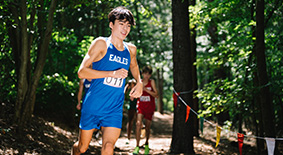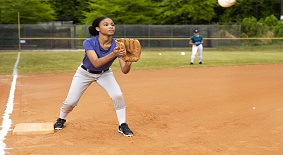How to Prevent Shin Splints in Young Athletes
Updated 11/11/22
Shin splints can be a painful obstacle for young athletes. Understanding risk factors and causes are key to preventing symptoms before they get worse.
When doctors talk about shin splints, they are referring to an irritation within the lining of the shin bones. It is an overuse injury brought on by repetitive impact activities such as running or jumping.
“The pain typically starts gradually, hurts worse during or after activity, and improves with rest,” explains Stephen Miller, MD, Sports Medicine Primary Care Provider at Children’s Healthcare of Atlanta. “Shin splints are preventable, but some teen athletes have a higher risk of developing shin splints because their sport requires more running or jumping.”

What causes shin splints?
Fortunately, athletes of all ages can take steps to avoid shin splints and further complications. Below are some elements that might put your teen athlete at risk for shin splints, making preventative steps especially important.
Risk factors for shin splints include:
- Increasing running mileage too fast.
- Running or jumping on hard surfaces.
- Running in shoes that lack proper support.
- Flat feet.
- Muscle imbalances in the lower leg and ankle.
Dr. Miller cautions that if pain continues to become more localized or more intense (possible stress fracture), or does not improve with temporary activity reduction and proper shoes, these are warning signs that require evaluation by a sports medicine physician.
Now that you have a better understanding of what shin splints are and the risk factors associated with the condition, let’s talk about prevention.
Whether your child is starting a new running program, returning after an injury or simply taking steps to prevent shin splints, make sure your child:
- Increases their mileage gradually (no more than 10-15% each week).
- Runs on soft, level surfaces, preferably on a rubberized cushioned track or a grassy cross-country trail. Running over hills, around stadiums, up and down bleachers or on hard pavement may increase the risk of developing shin splints.
- Has at least one full day of rest from running and jumping activities every week.
- Keeps their running shoes in good shape. They should be replaced every 350 miles or each year, whichever comes first.
- Adds some extra shock absorption to their shoes in the form of cushioned arch supports, especially if they have low arches or their feet pronate (rotate in or down).
- Tries a compression wrap, such as an ace bandage or a weave-type tape job over their shins while running. Some athletes get relief with this.
- Does exercises to strengthen their legs, like walking on their heels and toes.
- Stops the activity at the first sign of pain.
- Never tries to run through the pain, as it will only get worse and could cause further injury.
- Stretches before and after activity, focusing on the feet, ankles and calves to stretch all the muscles around the shins.
Can you play sports with shin splints?
Dr. Miller emphasizes the importance of prevention to help growing athletes perform at their best. He advises parents to see a sports medicine doctor about possible shin splints if your child has pain along the inner, lower edge of one or both the shin bones that flares up during running and jumping, but goes away with rest.
Dr. Miller says, “The pain associated with shin splints can progress to the point that running long distances or at a faster pace is extremely difficult. Taking steps to prevent shin splints can help keep your child on the track, field or court for as long as possible.”

Whether your teen athlete plays one sport or 10, where you take them matters.
The highly qualified and experienced pediatric sports medicine specialists at Children’s are dedicated exclusively to youth and teen athletes. Each member of our team is focused on getting kids back to doing the things they love most in the safest ways possible.
Find a SpecialistKeeping Young Athletes Healthy
Stephen Miller, MD, a Pediatric Sports Medicine Primary Care Physician, is board certified in pediatrics and sports medicine. He is a member of the Pediatric Research in Sports Medicine (PRiSM) organization, American Medical Society for Sports Medicine and American Academy of Pediatrics. His expertise is the diagnosis and nonsurgical management of all types of musculoskeletal injuries in growing athletes. He is also trained in managing sports-related concussions.
This content is general information and is not specific medical advice. Always consult with a doctor or healthcare provider if you have any questions or concerns about the health of a child. In case of an urgent concern or emergency, call 911 or go to the nearest emergency department right away. Some physicians and affiliated healthcare professionals on the Children’s Healthcare of Atlanta team are independent providers and are not our employees.
Contact Us 404-255-1933



